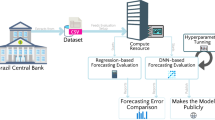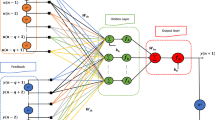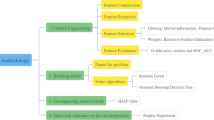Abstract
Applying neural network and error t-value test, this study trains and analyzes 28 interest rate changes of China’s macro-monetary policy and the mutual influences between reserve adjustments and financial markets for 51 times from 2000 to 2018 according to the data correlation between financial market and monetary policy. Through the principal component analysis, the bilateral financial risk system and data set are established, and the data set pre-process and dimensionality reduction are carried out to extract the most informative features. Six training cases are designed with processed features, and then the cases are input to each neural network model for combined prediction. Firstly, based on backpropagation neural network (BP), the forecasting model of monetary policy is established. Then, considering the importance characteristics of financial index data, expert weights based on BP, are introduced to propose weights backpropagation (WBP) model. On the basis of the timing characteristics of financial market, the WBP model is improved and the timing weights backpropagation (TWBP) model is proposed. Experiments show that different training cases bring out various effects. The accuracy rate of interest rate and reserve change value is lower than the original value after training. The mutation after data processing affects the learning of neural network. At the same time, the WBP and TWBP models improve according to the importance and timing characteristics of financial indicators have less errors in results, and the TWBP model has higher accuracy. When the number of hidden layers is 3, good results can be obtained, but in manifold training of the timing cycle, the efficiency of that is not as good as the WBP model.










Similar content being viewed by others
References
Black SE, Devereux PJ, Lundborg P (2017) On the origins of risk-taking in financial markets. J Financ 72(5):100–105
Riccioni J, Cerqueti R (2018) Regular paths in financial markets: investigating the Benford’s law. Chaos Solitons Fractals 107:186–194
Lin EMH, Sun EW, Yu MT (2018) Systemic risk, financial markets, and performance of financial institutions. Ann Oper Res 262(2):579–603
Lengnick M, Wohltmann HW (2016) Optimal monetary policy in a new Keynesian model with animal spirits and financial markets. J Econ Dyn Control 64:148–165
Dafermos Y, Nikolaidi M, Galanis G (2018) Climate change, financial stability and monetary policy. Ecol Econ 152:219–234
Platen E, Rebolledo R (1996) Principles for modelling financial markets. J Appl Probab 33(3):601–613
Li Kenli, Tang Xiaoyong, Li Keqin (2014) Energy-efficient stochastic task scheduling on heterogeneous computing systems. IEEE Trans Parallel Distrib Syst 25(11):2867–2876
Antipov A, Meade N (2002) Forecasting call frequency at a financial services call centre. J Oper Res Soc 53(9):953–960
Li C, Chiang TW (2013) Complex neurofuzzy ARIMA forecasting–a new approach using complex fuzzy sets. IEEE Trans Fuzzy Syst 21(3):567–584
Kayalar DE, Küçüközmen CC, Selcuk-Kestel AS (2017) The impact of crude oil prices on financial market indicators: copula approach. Energy Econ 61:162–173
Yuming Xu, Li Kenli, Jingtong Hu, Li Keqin (2014) A genetic algorithm for task scheduling on heterogeneous computing systems using multiple priority queues. Inf Sci 270:255–287
Ganda F (2019) The environmental impacts of financial development in OECD countries: a panel GMM approach. Environ Sci Pollut Res 5:11–15
Jian ZH, Zhu BS, Shuang LI (2012) Dynamic inflation target, money supply mechanism and China’s economic fluctuation: A DSGE-based analysis. Chin J Manag Sci
Yuming Xu, Li Kenli, He Ligang, Zhang Longxin, Li Keqin (2015) A hybrid chemical reaction optimization scheme for task scheduling on heterogeneous computing systems. IEEE Trans Parallel Distrib Syst 26(12):3208–3222
Chen J, Li K, Bilal K, Metwally AA, Li K, Yu PS (2018) Parallel protein community detection in large-scale ppi networks based on multi-source learning. IEEE/ACM Trans Comput Biol Bioinf. https://doi.org/10.1109/TCBB.2018.2868088
Chen C, Tiao GC (1990) Random level-shift time series models, arima approximations, and level-shift detection. J Bus Econ Stat 8(1):83–97
Einav L, Levin J (2014) Economics in the age of big data. Science 346(6210):124–130
Zhang XPS, Wang F (2017) Signal processing for finance, economics, and marketing: concepts, framework, and big data applications. IEEE Signal Process Mag 34(3):14–35
Araújo RDA (2012) A morphological perceptron with gradient-based learning for Brazilian stock market forecasting. Neural Netw 28:61–81
Chung H, Shin KS (2010) Genetic algorithm-optimized long short-term memory network for stock market prediction. Sustainability 10:3765
Li Kenli, Yang Wangdong, Li Keqin (2015) Performance analysis and optimization for SPMV on GPU using probabilistic modeling. IEEE Trans Parallel Distrib Syst 26(1):196–205
Chen Jianguo, Li Kenli, Tang Zhuo, Yu Shui, Li Keqin (2017) A parallel random forest algorithm for big data in spark cloud computing environment. IEEE Trans Parallel Distrib Syst 28(4):919–933
Lazer D, Kennedy R, King G (2014) Big data. the parable of Google Flu: traps in big data analysis. Science 343(6176):1203
Chiu MC, Pun CS, Wong HY (2017) Big data challenges of high-dimensional continuous-time mean-variance portfolio selection and a remedy. Risk Analysis 37(8):1532
Chen Jianguo, Li Kenli, Deng Qingying, Li Keqin, Yu Philip S (2019) Distributed deep learning model for intelligent video surveillance systems with edge computing. IEEE Trans Ind Inf. https://doi.org/10.1109/TII.2019.2909473
Yu L, Chen H, Wang S (2009) Evolving least squares support vector machines for stock market trend mining. IEEE Trans Evol Comput 13(1):87–102
Ebrahimpour R, Nikoo H, Masoudnia S (2011) Mixture of MLP-experts for trend forecasting of time series: a case study of the tehran stock exchange. Int J Forecast 27(3):804–816
Chen MY, Chen BT (2015) A hybrid fuzzy time series model based on granular computing for stock price forecasting. Inf Sci 294(2):227–241
Chen Jianguo, Li Kenli, Bilal Kashif, Zhou Xu, Li Keqin, Yu Philip S (2018) A bi-layered parallel training architecture for large-scale convolutional neural networks. IEEE Trans Parallel Distrib Syst 30(5):965–976. https://doi.org/10.1109/TPDS.2018.2877359
Chen J, Li K, Huigui R, Bilal K, Li K, Yu PS (2018) A periodicity-based parallel time series prediction algorithm in cloud computing environments. Inf Sci. https://doi.org/10.1016/j.ins.2018.06.045
Bengio Y, Delalleau O (2009) Justifying and generalizing contrastive divergence. Neural Comput 21(6):1601
Cao Z, Long C, Chao Z (2015) Spiking neural network-based target tracking control for autonomous mobile robots. Neural Comput Appl 26(8):1839–1847
Dahl GE, Sainath TN, Hinton GE (2013) Improving deep neural networks for LVCSR using rectified linear units and dropout. In: IEEE international conference on acoustics
Qian B, Rasheed K (2007) Stock market prediction with multiple classifiers. Appl Intell 26(1):25–33
Fratianni M, Marchionne F (2013) The fading stock market response to announcements of bank bailouts. J Financ Stabil 9(1):69–89
Patwary EU, Lee JY, Nobi A (2017) Changes of hierarchical network in local and world stock market. J Kor Phys Soc 71(7):444–451
Wu X, Lu H (2010) Exponential synchronization of weighted general delay coupled and non-delay coupled dynamical networks. Comput Math Appl 60(8):2476–2487
Lecun Y, Bengio Y, Hinton G (2015) Deep learning. Nature 521(7553):436
Song Y, Lee JW, Lee J (2018) A study on novel filtering and relationship between input-features and target-vectors in a deep learning model for stock price prediction. Appl Intell 49:897–911
Pang X, Zhou Y, Pan W (2018) An innovative neural network approach for stock market prediction. J Supercomput 1:1–21
Asadi S, Hadavandi E, Mehmanpazir F (2012) Hybridization of evolutionary Levenberg-Marquardt neural networks and data pre-processing for stock market prediction. Knowledge-Based Syst 35(15):245–258
Yu-Hui T, Wei K, Shou-Ning Q (2010) Research on stock quotation based on improved rough lattice model. IEEE 3:442–445
Yoo PD, Kim MH, Jan T (2005) Financial forecasting: advanced machine learning techniques in stock market analysis. IEEE, 1–7
O’Connor N, Madden MG (2006) A neural network approach to predicting stock exchange movements using external factors. Knowledge-Based Syst 19(5):371–378
Chen Yuedan, Li Kenli, Yang Wangdong, Xiao Guoqing, Xie Xianghui, Li Tao (2019) Performance-aware model for sparse matrix-matrix multiplication on the sunway TaihuLight supercomputer. IEEE Trans Parallel Distrib Syst 30(4):923–938
Maknickiené N, Maknickas A (2013) Financial market prediction system with Evolino neural network and Delphi method. Physiologia Plantarum 14(2):403–413
Jie W, Wang J (2017) Forecasting stochastic neural network based on financial empirical mode decomposition. Neural Netw 90:8–20
Xiao Guoqing, Li Kenli, Li Keqin (2017) Reporting l most influential objects in uncertain databases based on probabilistic reverse top-k queries. Inf Sci 405:207–226
Desai VS, Bharati R (2010) The efficacy of neural networks in predicting returns on stock and bond indices. Decis Sci 29(2):405–423
Xiao G, Li K (2019) CASpMV: a customized and accelerative SPMV framework for the sunway TaihuLight. IEEE Transactions on Parallel and Distributed Systems pp. 1–1. https://doi.org/10.1109/TPDS.2019.2907537
Lin A, Shang P, Zhou H (2014) Cross-correlations and structures of stock markets based on multiscale MF-DXA and PCA. Nonlinear Dyn 78(1):485–494
Statistical data: National bureau of statistics of china (nbsc). URL http://www.stats.gov.cn/
iFind: Hithink flush information network co., ltd. (ifind). URL http://www.51ifind.com/
CSMAR: Tai’an information technology co., ltd. (csmar). URL http://www.gtarsc.com/
Leshno M, Lin VY, Pinkus A (1991) Original contribution: multilayer feedforward networks with a nonpolynomial activation function can approximate any function. Neural Comput 6(6):861–867
Mandic DP, Chambers JA (1999) Relating the slope of the activation function and the learning rate within a recurrent neural network. Neural Comput 11(5):1069–1077
Acknowledgements
This work was supported social science research base of finance and accounting research center of Fujian province, in part by asset evaluation research project of Fujian social science planning and research base under Grant JXY201801-08 and JXY201801-05, in part by the “Internet+” virtual simulation experimental teaching platform for the key project of the young and middle-aged teachers in Fujian province under Grant JZ180190, in part by the active project reporting mode under the background of cloud network in the major project of Fujian province social science base in 2018 Research under Grant FJ2018JDZ014, in part by the project of Fujian institute of technology under Grant GB-RJ-17-58.
Author information
Authors and Affiliations
Corresponding author
Ethics declarations
Conflict of interest
The author Minrong Lu is from Fujian Jiangxia University, and he declares that he has no conflict of interest.
Additional information
Publisher's Note
Springer Nature remains neutral with regard to jurisdictional claims in published maps and institutional affiliations.
Rights and permissions
About this article
Cite this article
Lu, M. A monetary policy prediction model based on deep learning. Neural Comput & Applic 32, 5649–5668 (2020). https://doi.org/10.1007/s00521-019-04319-1
Received:
Accepted:
Published:
Issue Date:
DOI: https://doi.org/10.1007/s00521-019-04319-1




